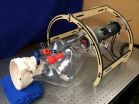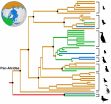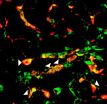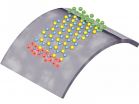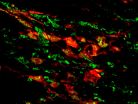(Press-News.org) NEWPORT, Ore. – Pacific sleeper sharks, a large, slow-moving species thought of as primarily a scavenger or predator of fish, may be preying on something a bit larger – protected Steller sea lions in the Gulf of Alaska.
A new study found the first indirect evidence that this cold-blooded shark that can grow to a length of more than 20 feet – longer than a great white shark – may be an opportunistic predator of juvenile Steller sea lions.
Results of the study have just been published in the journal Fishery Bulletin. The findings are important, scientists say, because of management implications for the protected Steller sea lions.
For the past decade, Markus Horning of the Marine Mammal Institute at Oregon State University has led a project to deploy specially designed "life history transmitters" into the abdomens of juvenile Steller sea lions. These buoyant archival tags record data on temperature, light and other properties during the sea lions' lives and after the animals die the tags float to the surface or fall out ashore and transmit data to researchers via satellite.
From 2005-11, Horning and his colleagues implanted tags into 36 juvenile Steller sea lions and over a period of several years, 17 of the sea lions died. Fifteen transmitters sent data indicating the sea lions had been killed by predation.
"The tags sense light and air to which they are suddenly exposed, and record rapid temperature change," said Horning, who is in OSU's Department of Fisheries and Wildlife. "That is an indication that the tag has been ripped out of the body, though we don't know what the predator is that did this.
"At least three of the deaths were different," he added. "They recorded abrupt temperature drops, but the tags were still dark and still surrounded by tissue. We surmise that the sea lions were consumed by a cold-blooded predator because the recorded temperatures aligned with the deep waters of the Gulf of Alaska and not the surface waters.
"We know the predator was not a killer whale, for example, because the temperatures would be much higher since they are warm-blooded animals." Data collected from the transmitters recorded temperatures of 5-8 degrees Celsius.
That leaves a few other suspects, Horning said. However, two known predators of sea lions – great white sharks and salmon sharks – have counter-current heat exchanges in their bodies that make them partially warm-blooded and the tags would have reflected higher temperatures.
By process of elimination, Horning suspects sleeper sharks.
The Oregon State pinniped specialist acknowledges that the evidence for sleeper sharks is indirect and not definitive, thus he is planning to study them more closely beginning in 2015. The number of sleeper sharks killed in Alaska as bycatch ranges from 3,000 to 15,000 annually, indicating there are large numbers of the shark out there. The sleeper sharks caught up in the nets are usually comparatively small; larger sharks are big enough to tear the fishing gear and are rarely landed.
"If sleeper sharks are involved in predation, it creates something of a dilemma," said Horning, who works out of OSU's Hatfield Marine Science Center in Newport, Ore. "In recent years, groundfish harvests in the Gulf of Alaska have been limited in some regions to reduce the potential competition for fish that would be preferred food for Steller sea lions.
"By limiting fishing, however, you may be reducing the bycatch that helps keep a possible limit on a potential predator of the sea lions," he added. "The implication could be profound, and the net effect of such management actions could be the opposite of what was intended."
Other studies have found remains of Steller sea lions and other marine mammals in the stomachs of sleeper sharks, but those could have been the result of scavenging instead of predation, Horning pointed out.
The western distinct population of Steller sea lions has declined to about 20 percent of the levels they were at prior to 1975.
INFORMATION:
The study was supported by multiple organizations.
Astronomers using the National Science Foundation's Green Bank Telescope (GBT) in West Virginia, along with data from other large radio telescopes, have discovered that our nearest galactic neighbors, the dwarf spheroidal galaxies, are devoid of star-forming gas, and that our Milky Way Galaxy is to blame.
These new radio observations, which are the highest sensitivity of their kind ever undertaken, reveal that within a well-defined boundary around our Galaxy, dwarf galaxies are completely devoid of hydrogen gas; beyond this point, dwarf galaxies are teeming with star-forming ...
"If you have a coin and flip it just once, what does that tell you about the odds of heads versus tails?" asks Heather Knutson, assistant professor of planetary science at Caltech. "It tells you almost nothing. It's the same with planetary systems," she says.
For as long as astronomers have been looking to the skies, we have had just one planetary system—our own—to study in depth. That means we have only gotten to know a handful of possible outcomes of the planet formation process, and we cannot say much about whether the features observed in our solar system ...
For those most severely affected, treating epilepsy means drilling through the skull deep into the brain to destroy the small area where the seizures originate – invasive, dangerous and with a long recovery period.
Five years ago, a team of Vanderbilt engineers wondered: Is it possible to address epileptic seizures in a less invasive way? They decided it would be possible. Because the area of the brain involved is the hippocampus, which is located at the bottom of the brain, they could develop a robotic device that pokes through the cheek and enters the brain from ...
Having had children – particularly early in life – and a dysfunctional romantic relationship are the two most frequently cited reasons when low-income mothers are asked about why they find themselves in poverty. So say American researchers Kristin Mickelson of the School of Social and Behavioral Sciences at Arizona State University, and Emily Hazlett of Kent State University and the Northeast Ohio Medical University, in a new article published in Springer's journal Sex Roles. The researchers believe that how a woman answers the question of "why me?" when thinking ...
Modern-day puffins and auks have long been recognized as environmental indicator species for ongoing faunal shifts, and fossil records now indicate that ancient relatives were similarly informative. Researchers have found that puffins and auks may have been at their most diverse and widespread levels during a relatively warm period of Earth's history. The results also explain how past extinctions have shaped the geographic distribution and population size of existing species.
Authors Adam Smith of the National Evolutionary Synthesis Center (NESCent) in Durham, N.C., and ...
COLLEGE PARK, Md. – A new analysis of global energy use, economics and the climate shows that without new climate policies, expanding the current bounty of inexpensive natural gas alone would not slow the growth of global greenhouse gas emissions worldwide over the long term, according to a study appearing today in Nature.
Because natural gas emits half the carbon dioxide of coal, many people hoped the recent natural gas boom could help slow climate change—and according to government analyses, natural gas did contribute partially to a decline in U.S. carbon ...
This market effect erases the advantage of lower emissions from the natural gas itself, according to an unprecedented international comparison of computer simulations.
"The upshot is that abundant natural gas alone will not rescue us from climate change," says the lead author Haewon McJeon of the Department of Energy's Pacific Northwest National Laboratory (PNNL). Especially in the US advances such as hydraulic fracturing – pumping liquids into stone to break it up and release the gas, known as fracking – and horizontal drilling have led to bountiful natural ...
UCLA researchers have discovered that some scar-forming cells in the heart, known as fibroblasts, have the ability to become endothelial cells — the cells that form blood vessels. The finding could point the way toward a new strategy for treating people who have suffered a heart attack, because increasing the number of blood vessels in the heart boosts its ability to heal after injury.
In studies involving mice, the UCLA team also found that a drug could enhance this phenomenon and improve the repair process after a heart attack.
The research is published in the ...
New York, NY—October 15, 2014—Researchers from Columbia Engineering and the Georgia Institute of Technology report today that they have made the first experimental observation of piezoelectricity and the piezotronic effect in an atomically thin material, molybdenum disulfide (MoS2), resulting in a unique electric generator and mechanosensation devices that are optically transparent, extremely light, and very bendable and stretchable.
In a paper published online October 15, 2014, in Nature, research groups from the two institutions demonstrate the mechanical ...
CHAPEL HILL – Researchers from the UNC School of Medicine have discovered that cells called fibroblasts, which normally give rise to scar tissue after a heart attack, can be turned into endothelial cells, which generate blood vessels to supply oxygen and nutrients to the injured regions of the heart, thus greatly reducing the damage done following heart attack.
This switch is driven by p53, the well-documented tumor-suppressing protein. The UNC researchers showed that increasing the level of p53 in scar-forming cells significantly reduced scarring and improved heart ...


